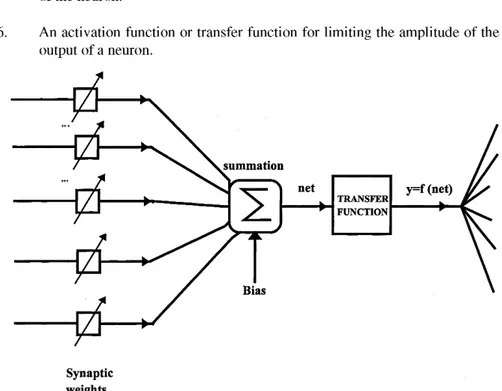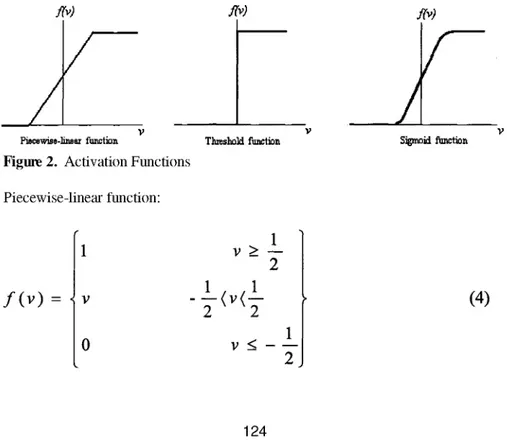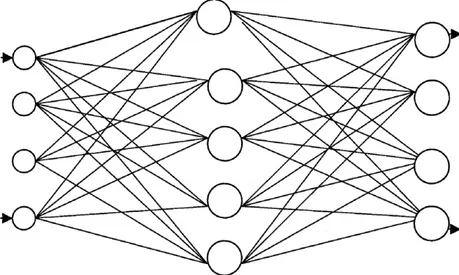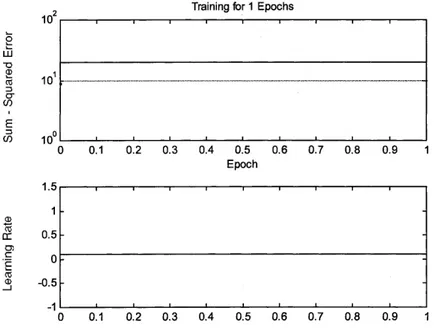NETWORKS APPROACH
M Ziarati
Dogus University, Compute Engineering Depcaiment O. N. Ucan
Istanbul University, Electric and Electronics Depcaiment R . Ziarati
Dogus University, Compute Engineering Depcaiment
ABSTRACT : In this paper, a Back Propagation-Artificial N eural N etw ork (BP- ANN) has been adapted for predicting the required car parts quantities in a real and m ajor auto parts supplier chain. The conventional approach to determine the parts requirem ents is the Economic Order Quantity (EOQ) method. Thé ability of neural models to learn, particularly their capability of handling large amounts of data .siiiiultaneously as \\ ell as their fàst'respqtisé tiiiie, are the characteristics desired for predictive and forecasting purposes. Here, the actual data obtained from a major auto parts supplier chain, involving a multi-layer system of supplying auto parts to car dealers, have been used to optimise and develop a BP-ANN model. The model has shown promising results in predicting parts orders w ith high degree of accuracy, Keywords: A rtificial Meural N etw ork (A N N ), Econom ic Order Quantity (EOQ).
ÖZET : ¡'in makalede. Geri yayihm h Yapay Sinir Ağ ! YSA.ı yapıları gerçek bir anıha parçası sağlayan bir firmaya uygulanmıştır. Klasik yaklaşım, istenen talepleri Ekonomik Sipariş M iktarı (ESM) ile belirlemektir. Y SÂ ’nm eğitilebilir olması ve büyük m eblağlı setleri paralel ve lu/lı çözebilmesi geleceğe dönük siparişleri tahm in etm e şansı doğurmaktadır. Burada gerçek bir firmanın akış şen imm. ana satıcı
firmalarla bağıntıları YSA yaklaşım ı ile optimise edilmiş ve yeni bir YSÀ önerilmiştir. Sonuçların çok doğruya yakın bulunmuş olması, YSA m odelinin gelecek vadetmesıni sağlamaktadır.
INTRODUCTION
The problem of determining the required number of parts in a supplier chain system is well known. The Economic Order Quantity (EOQ) approach is employed for prediction of required quantities by many businesses particularly supplier chains [1]. To find the ‘exact’quantities, the EOQ approach is often complemented by a series of "rule of thumb" expressions. These rules are applied on a basis of the historical learning and hence to reduce the effect of the deficiency of the EOQ method. The problem of deciding on a required number of parts are further complicated by seasonal variations. This paper offers an alternative approach to the EOQ approach by adapting a neural network model. The neural networks are primarily suited to identifying trends and patterns, particularly when there is a large amount of data. The predictive and forecasting ability of the neural network are of particular interest in parts supply and sales.
The down-side of these networks are the initial stage of application. Adequate data needs to be initially available for training of the network. Then the training phase needs to be followed by testing, verification and the latter two phases need to consider stability problems inherent in neural networks.
1. NEURALNETWORKS - GENERAL
The neural models are basically based on the perceived work of the human brain. The artificial model of the brain is known as Artificial Neural Network (ANNs) or simply Neural Networks (NNs). Neural Networks have many applications. Their ability to learn seemingly large amount of abstract data and to inter-relate different sets of information makes them ideal tools for application in the parts supplier chains.
Generally, however, the ANNs is a cellular information processing system designed and developed on the basis of the perceived notion of the human brain and its neural system. The network is composed of large numbers of neurons and their intra-and inter-connections [2].
1.1 The Biological Model
The brain is highly complex, nonlinear and parallel information processing system. It has the capability to organise its structural constituents known as neurons so as to perform certain computations many times faster than the fastest digital computer in existence today. There exists more than 100 billion neurons of different types highly interconnected with each other via synapses of which there are more than a 150 billion.
Neurons are specialized cells that serve as the functional and structural units of our nervous system. The nervous system itself can be divided into two separate
chord, and the peripheral nervous system, which connects the central nervous system with the rest of the body. In turn, the peripheral neurons can be broken down into different divisions, one of which is the sympathetic nervous system. Sympathetic neurons generally act without any conscious control and they participate in many of our physiological responses to stress. The increase in heart rate, sweaty palms, and churning stomach are the result of our sympathetic neurons. The cell body contains the nucleus of the cell, a warehouse for manufacturing cell machinery. The dentrites radiate outward from the cell body and, in general, receive stimuli from external sources, including other neurons. Once the neuron is stimulated, an electrical impulse travels from the dendrites to the cell body and finally into the axon. The axon propagates the impulse to the synaptic terminal and stimulates the release of chemicals called neurotransmitters. These chemicals can stimulate the dentrites of surrounding neurons if the cellular body accumulates enough electrical potential to overcome a certain threshold, the action potential, and if they do so, the cycle is renewed in the neuron’s neighbours. Also note that the rapid, efficient propagation of electrical and chemical impulses is the distinctive characteristic of neurons and the nervous system in general. It generates memories, emotions, and imagination.
1.2. Artificial Neural Network
The neurons operate collectively and simultaneously on most for all data and inputs which performs as summing and nonlinear mapping junctions. In some cases they can be considered as threshold units that fire when total input exceeds certain bias level. Neurons usually operate in parallel and are configured in regular architectures. They are often organized in layers, and feedback connections both within the layer and toward adjacent layers are allowed. Each connection strength is expressed by a numerical value called a weight which can be modified. Also they are characterized by their time domain behaviour which is often referred as dynamics.
In general, the neuron could be modelled as an nonlinear activated function of which the total potential inputs into synaptic weights are applied. It is assumed that synapses can impose excitation or inhibition but not both on the receptive neuron. Also axons are modelled as transmission lines and dendrites are the receptive zones and the synapses are elementary structural and functional units that mediate the interaction between neurons. From the biological view, the artificial model of neuron should consist of three elements (Figure 1). These are,
1. A set of synapses or connection links, each of which is characterized by a
weight or strength of its own. Specially, a signal xj at the input of synapse j
connected to neuron k is multiplied by the synaptic weight Unlike a
synapse in the brain, the synaptic weight of an artifical neuron may lie in a range that includes negative as well as positive values.
2. An adder for summing the input signals, weighted by the respective synapses of the neuron.
3. An activation function or transfer function for limiting the amplitude of the
output of a neuron.
In general, the neuron could be modelled as an nonlinear activated function of which the total potential inputs into synaptic weights are applied. It is assumed that synapses can impose excitation or inhibition but not both on the receptive neuron. Also axons are modelled as transmission lines and dentrites are the receptive zones and the synapse are elementary structural and functional units that mediate the interaction between neurons. From the biological view, the artificial model of neuron should consist of three elements (Figure 1). These are,
4. A set of synapses or connection links, each of which is characterized by a
weight or strength of its own. Specially, a signal xj at the input of synapse j connected to neuron k is multiplied by the synaptic weight wkj. Unlike a synapse in the brain, the synaptic weight of an artifical neuron may lie in a range that includes negative as well as positive values.
5. An adder for summing the input signals, weighted by the respective synapses
of the neuron.
6. An activation function or transfer function for limiting the amplitude of the
output of a neuron.
Synaptic weights
bias bk has the effect of increasing or lowering the net input of the activation function depending on whether it is positive or negative, respectively. Where xp. . ,.,xm are the input signals; wk1,....w km are the synaptic weights of neuron k. The activation function, denoted by f(net), defines the output of a neuron which considerably influences the behaviour of the network. Here, sigmoid is chosen as an activation function as shown in Figure 2.
Mathematically, the neuron k will be described by the following equations:
where x1, . . , x m are the input signals; wk1, . . w km are the synaptic weights of neuron k. The activation function, denoted by f(net), defines the output of a neuron which
considerably influences the behavior of the network. Here, three basic types of activation function is introduced.
(
1
)
y k = f { n e t )(
2
)
(3)
m m m v Piecewise-linear function V V Threshold functionFigure 2. Activation Functions
Piecewise-linear function: 1 V > -
2
(4)
0 v < ---1 2Threshold function:
M
= \ o
(5)
Sigmoid function:
/(v) = ---
(6)
1 + exp(-av)
where a is the slope parameter of the sigmoid function.
2. APPLICATION OFANNs IN FORECASTING
The data gathered on the purchases by six motor car dealers from a parts supplier during a two-year period was used as input to the artificial neural network described above. Under consideration were 69 different parts supplied to 5 dealers at different times and quantities. The ordering of parts by dealers were arbitrary and were based on previous trends in demand for a given part or immediate request from a customer. It has been difficult for the parts supplier to establish a ‘just in time’ approach and often their existing ‘just in case’method had lead to excessive parts being stored in their central and regional warehouses.
The objective of the current investigation is not to concentrate on the nuts and bolts of how companies in a parts supply chain operate, but to investigate the applicability of ANNs in forecasting auto parts requirements within the chain. It is also of interest to see if a just-in-time approach can be established between the parts supplier and the dealers on the one hand and the dealers and their customers on the other. Such an approach will lead to the timely manufacture and delivery of parts to the parts supplier.
In our case, we have applied Back Propagation Artificial Neural Network (BP- ANN) algorithm. Back propagation is an feedback error correction method which is commonly used in ANN. Our BP-ANN structure has 69 input entries at the input layer layer, corresponding to the all possible input items produced by our sample factory. We prefer 71 hidden layer neurons. Generally, hidden neuron number is chosen greater than input entries. The output neuron number is equal to input entries as 69, since we are estimating the selling amount of same five main dealers with similar items of production.
Since we are working on forcasting problem of a real factory, the number of the input entries and output neurons are to be in same. Using Equations (1-6), we estimate five main dealers selling of 69 different items, each corresponding some parts of a car. In our problem, we train the system to the ANN for the past 6 weeks data. After reaching desired training squared sum of error value as 20.77 (Figure 4), we try to find following expected sales using weight coefficients of our BP-ANN model (Figure 4).
Training for 10000 Epochs
10 cr (/) tn> 0 1000 2000 3000 4000 5000 6000 7000 8000 9000 10000 Epoch x 10 3000 4000 5000 6000 7000 8000 9000 10000 Epoch
Figure 4. Sum-squared Error and Learning Rate during training procedure. of BP-
Here, Sum-squared Error means that squared difference of all pixel values of input and output matrix are taken and then added, giving a global efficiency parameter of an optimisation problem .
After training procedure is finished with satisfactory results shown as in Figure 4, we use the following 3 weeks of data as an input and forecast the fore-coming 3 weeks future data. As shown in Figure 5, without any training and thus as a real time working, we have found satisfactory squared sum of error as 19.97. Thus we can conclude that our ANN model is suited well for our problem.
Training for 1 Epochs
1 0 ---1--- 1---1---1---1--- 1---o LU E 3 o co 10 _____1_____1_____1_____1_____1_____1_____1_____1_____1_____ 0 0.1 0.2 0.3 0.4 0.5 0.6 0.7 0.8 0.9 1 Epoch 1.5 I--- 1--- 1--- 1--- 1--- 1--- 1--- 1 I I---1 - -0) i r 0.5 - -ai I o : : ® -0.5 -
-_ - | -_-_-_-_-_-_-_-_-_-_-_ I-_-_-_-_-_-_-_-_-_-_ I-_-_-_-_-_-_-_-_-_-_-_ I-_-_-_-_-_-_-_-_-_-_-_-_-_-_ I-_-_-_-_-_-_-_-_-_-_-_ I--- - -- ---
1---0 0.1 0.2 0.3 0.4 0.5 0.6 0.7 0.8 0.9 1
Figure 5. Sum-squared Error and Learning Rate for real data 3. CONCLUSION
In this paper, a Back Propagation-Artificial Neural Network (BP-ANN) model has been developed for the optimisation of parts quantities required in a large auto car supplier chain. The ability of neural models to learn, particularly their capability of handling large amounts (or sets) of data simultaneously as well as their fast response time, are invariably the characteristics desired for predictive and forecasting purposes. The BP-ANN model has 69 inputs, 71 hidden and 69 output neurons. The figure of 5 corresponds to the auto parts under consideration and quantity needs to be predicted.
The model was tested using actual data in a given supplier chain. The predictions as shown are very promising. The model can easily be adapted to have far larger inputs. It is also feasible to consider other forms of Neural Networks.
components and parts down stream or up stream of supplier chains with high of degree of accuracy.
4. REFERENCES
[1] ZIARATI, M (2000), "Improving the Supply Chain in the Automotive Industry Using Kaizen Engineering" MPhil transfer report, De Montfort University, UK. [2] HAYKIN,S. (1999), " Neural Networks"John Wiley Pub.



